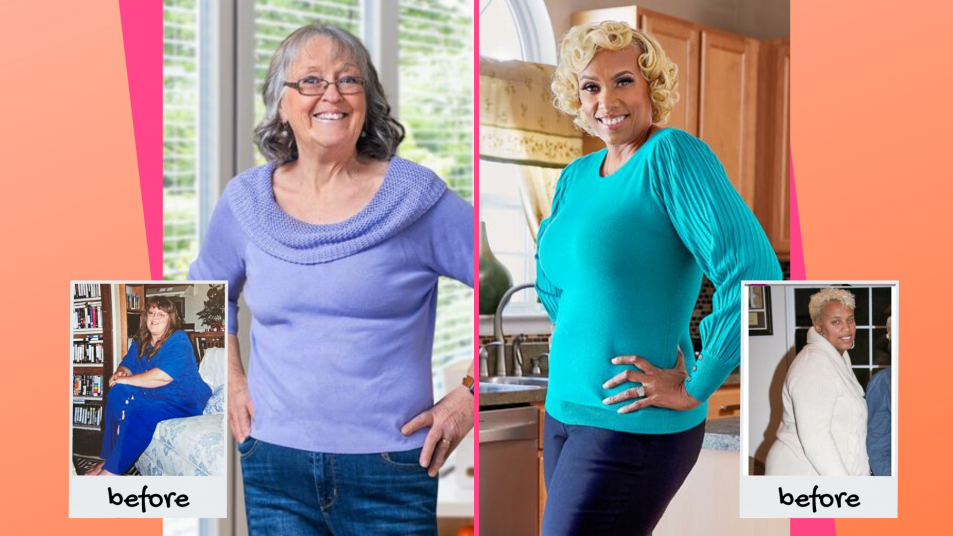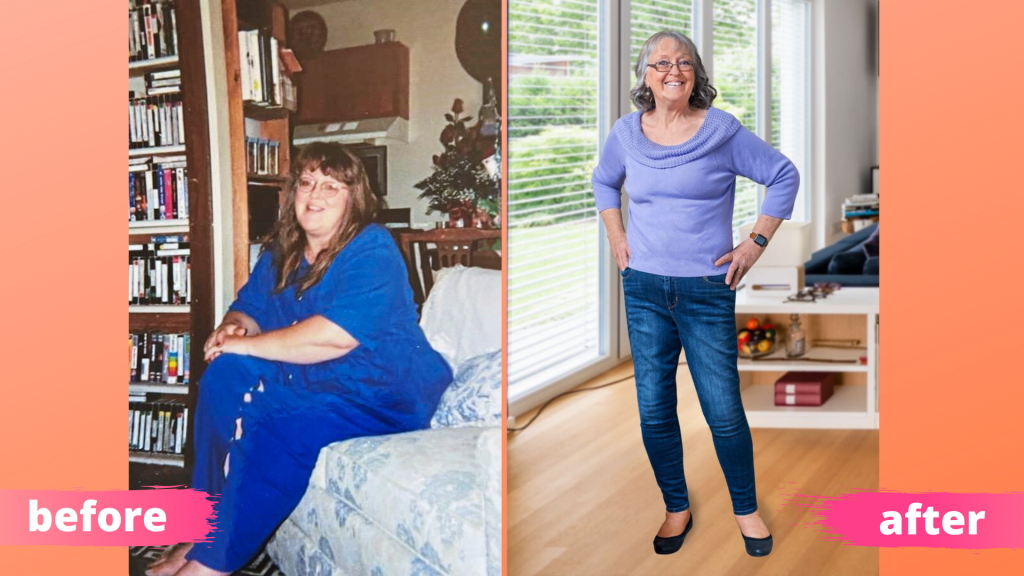Dr. Ian Smith’s 3-Week “Confuse It to Lose It” Plan Works Wonders for Women Over 40
It helped Debbie and LeKeisha lose 100+ lbs!

There’s a reason most diets fail long-term. And the answer may surprise you. It’s not because the plans are too regimented. The human body often craves repetitive habits. Instead, it’s the consistency that may be sabotaging you. Scientists at the National Institutes of Health report that consistent dieting actually has the reverse effect as intended: it slows metabolism and makes it twice as hard for the body to drop excess pounds. It seems our progress plateaus when our dieting landscape becomes too familiar. So we reached out to Harvard-educated physician Ian Smith, MD, who contends that a changing food formula is best for boosting metabolism, especially after age 40. Keep reading to learn more about the Ian Smith diet and check out two amazing success stories at the end.
The problem with traditional diets
Repetitive diet plans can create a condition called weight-loss intolerance. “The body’s number one goal is to be efficient, so it learns how to adjust to every scenario you throw at it,” explains Dr. Smith, a familiar face from the syndicated television show The Doctors and author of The Met Flex Diet. Learning exactly how much energy your body needs to perform its daily functions, it burns just enough calories to keep it going and stores the rest as fat for a possible emergency. So no matter what type of consistent diet plan you try — whether it’s keto or vegan — your body will acclimate, your metabolism will slow and weight loss will stall.
How to outsmart any diet rut
Determined to help women overcome weight-loss intolerance, Dr. Smith dug into the research and created a three-pronged plan built on a foundation of science-backed approaches. Each strategy is effective on its own, but combining them stops the body from settling into a tired routine. It’s about changing things up often to keep the metabolism working hard. “Every week is different. It doesn’t give your body the chance to become acclimated to a consistent style of eating,” says Dr. Smith.
Do these 3 things to keep your metabolism on its toes
Dr. Smith designed a special, three-week plan exclusively for FIRST. It features alternating food formulas to power off stubborn pounds. Check out Dr. Smith’s three favorite wiggle-room approaches:
- Adjust your time-restricted eating window. By now you’ve likely heard how shortening your eating window, a practice called intermittent fasting, can help with weight loss. But Dr. Smith advises making your fasting window flexible. By changing the hours your body expects food — during 10 hours one day or 12 hours another day — you’ll keep your metabolism humming. Intermittent fasting helps to regulate fat-storage hormones. In fact, weight loss naturally happened when people lower their levels of insulin, the hormone that instructs fat cells to hold on to their stores of excess energy, explains Dr. Smith. Without insulin, the body shifts to burn fat for energy.
(Click to read our intermittent fasting diet guide.) - Eat different plant-based fibers. Eating plenty of nutrient-rich, fiber-filled foods triggers the brain to release hunger-dampening hormones. “Fiber slows digestion, which makes you feel full longer,” Dr. Smith explains. That’s an advantage that increased dieters’ weight loss by 400%, according to Purdue University research.
Related: The “Skinny” Fiber That’s Helping Women Heal Their Guts and Lose Weight - Switch up calorie intake. To speed metabolism, eat a low-calorie diet two days a week (800 calories a day maximum) and a higher-calorie diet (up to 1,600 calories) the other five days. This throws the body off-kilter in a way that stimulates fat burning. Indeed, New Zealand researchers found that this approach doubles fat loss compared to diets that call for steady calorie intake.
This Dr. Ian Smith diet really works!

Women following Dr. Smith’s latest plan drop up to 11 pounds a week. Just ask 47-year-old Stacie Ickes, who teamed up with her sister and mom to try Dr. Smith’s diet plan. “Intermittent fasting helped keep my metabolism on its toes,” says the preschool teacher. “Changing every once in a while shakes up your system. I never had a week where I gained.”
Amazing benefits besides weight loss
Weight loss is just the beginning here. “I look to the future now, and I feel it’s possible to be healthy,” cheers Stacie, who is sleeping better and feels more energized in addition to having lost 38 pounds. Says Dr. Smith, “Most of us gauge a diet’s success by the number on the scale, and while that’s important, my plan helps when it comes to living better and longer. I keep hearing from people who’ve lowered their blood-sugar levels to the point of having their diabetes medication cut in half. I’ve heard from others who’ve lowered their cholesterol and feel amazing.” Ready to start? Read on!
Keep reading to try this Ian Smith diet for yourself…
Here’s how to use Dr. Ian Smith’s diet plan for 3 weeks….and keep reading for real-life success stories.
Week 1: Blast stubborn fat
This week, you’ll fast for 12 hours every day and eat every three hours for the rest of the day — for a total of three meals and one or two snacks. “Eating a meal or snack about every 3 hours helps you avoid getting too hungry,” says Dr. Smith. “Also, eat slowly and mindfully enough that you can listen to your body’s cues that you are full.” You can choose the starting and ending times for your fasting window. Just make sure you’re not accidentally breaking your fast by drinking sugary coffee or tea. (Click to read Dr. Ian Smith’s 2-day fat blast plan, using intermittent fasting.)
SAMPLE DAY
- Breakfast (after a 12-hour fast): 1 cup of lemon water, 1 piece of fruit (1 banana or apple or 1⁄2 cup of berries), 1 small bowl of sugar-free cereal with 2% milk
- Snack 1 (2 hours after breakfast): 8 baby carrots with 2 Tbs. of hummus or other bean dip
- Lunch (3 hours after snack): Large green salad with lots of veggies, 3 oz. of chicken and 2 Tbs. of fat-free dressing
- Snack 2 (2 hours after lunch): 1 cup of unsweetened applesauce
- Dinner (3 hours after snack): 6 oz. of grilled or steamed salmon or other fatty fish (like tuna or trout) with at least 1 cup of mixed steamed vegetables
Week 2: Ward off hunger
Time to mix things up! You’ll increase your fasting time—eating during a 10-hour window and fasting for 14 hours each day. You’ll aim to eat four small meals a day, keeping most (or all, if possible) of those meals totally plant-based. If you’re more of a meat eater, it’s okay to add 3 oz. of chicken or fish to one meal every other day. “The goal this week is to feel satisfied while keeping your calories low,” says Dr. Smith, “and the best way to do that is to get all of the protein and fiber you need through a plant-based diet.”
PLANT-BASED SAMPLE DAY
- Breakfast (after a 14-hour fast): 1 1/2 cups of oatmeal with 1⁄2 cup of fresh fruit
- Lunch (2 hours after breakfast): Large salad with greens, olives, cherry tomatoes, nuts, cucumbers and beans. Top with 2 Tbs. of fat-free vinaigrette
- Large snack (3 hours after lunch): Wrap your favorite roasted veggies (try peppers, onions, mushrooms and cherry tomatoes) and a dash of balsamic vinegar in a whole-grain tortilla with a slice of cheese
- Dinner (2 hours after snack): 1 cup of whole-wheat pasta in marinara sauce topped with sautéed zucchini and eggplant. Garnish with shredded cheese and basil
Week 3: Supercharge metabolism
You’ve probably noticed fat is melting away and you’re feeling energized. This week, pick the fasting window that feels most comfortable (12 or 14 hours) and add a “flash fasting” strategy. This means that five days this week, you’ll eat about 1,600 calories (similar to what you ate during week 1) and on the other two days, you’ll eat 800 calories. “This week will be a bit of a challenge, but I’ve seen it lead to noticeable results,” Dr. Smith says. “It can also make the scale move again if you’ve plateaued.”
LOW-CALORIE SAMPLE DAY
- Breakfast (after a 12- or 14-hour fast): In a blender, combine 1⁄4 cup of milk, half of a medium ripe banana, 1 Tbs. of creamy peanut butter, 1 cup of fresh or frozen raspberries and 1⁄2 cup of crushed ice
- Snack 1 (3 hours after breakfast): 1 cup of grape tomatoes
- Snack 2 (2 hours after snack): 1 hard-boiled egg with 1⁄2 cup of sugar snap peas
- Snack 3 (2 hours after snack): 1medium cucumber sprinkled with balsamic vinaigrette
- Dinner (2-3 hours after snack): 1 1⁄2 cups of vegetable soup, either homemade or from a BPA-free can, topped with 1⁄2 cup of beans or 3 oz. of lean protein, like chicken breast
If you like Dr. Ian Smith’s 3-week plan, check out his full nine-week plan in his book Fast Burn. And check out these inspiring success stories…
Weight Loss Success: LeKeisha Watson, 43
“I dropped from size 26 to 8!”

LeKeisha Watson, 43, of Wilmington, Delaware, sat in the fitting room and cried. She’d gone dress shopping with women from her office, but at 304 lbs., LeKeisha couldn’t find anything in her size at the mall. She realized, My choices are so limited. I have to make a change.
LeKeisha felt weight problems were her family’s curse. To break it, LeKeisha gave up meat for 30 days. She dropped 13 pounds in one month and continued experimenting with a plant-based diet. She kept her metabolism guessing by doing weekly challenges like giving up bread and fasting overnight.
LeKeisha knew her body was transforming when she could tuck in her shirt. “It might sound funny, but that was a big moment!” She adds, “I went to my sister’s house just to show her my belt.”
In all, LeKeisha has shed 117 pounds, improved her energy, erased chronic back pain and feels years younger. She even inspired her daughter to lose 65 pounds.
Today, at 187 lbs., LeKeisha thanks God her healthy journey happened when it did. She has since survived battles with cancer and COVID. “I wouldn’t have had the strength to fight if I had still been unhealthy,” she reveals. “We hear a lot about generational wealth, but generational health is just as important. It is the best legacy I can leave for my children!”
Weight loss success: Debbie Yearwood, 67
“I’m saving $2,000 a month on meds!”

Thick smoke filled the hallway, but Debbie Yearwood, 67, of Miami, Oklahoma, stood motionless, leaning against her walker. The building was on fire, the elevators shut down, but Debbie knew she couldn’t get down the stairs. If I get out of this, I have to regain control, she promised herself. My weight is impacting my safety!
As Debbie’s weight climbed up to 279 lbs., she was taking 10 prescription medications and she became desperate to undo the damage. Debbie began eating a keto diet and seeing results. But the diet felt restrictive, so over the months, she slowly adopted a flexible plant based lifestyle, including intermittent fasting. She also tracked her food using the free app LoseIt!
The weight kept melting away. Five months later, Debbie was down 79 pounds, and within six months, with her doctor’s approval, she stopped taking all 10 medications, saving her $2,000 a month. Thanks to all those fiver-rich nuts, seeds and leafy greens, Debbie says, “This diet reduced inflammation, altered my brain chemistry and reversed all my health issues.” As a bonus, she saves up to $300 on groceries a month. “I haven’t eaten anything after supper in over a year and I feel great!”
Now, at 169 lbs., Debbie has her freedom. She can even walk more than five miles. “I love to go up and down the stairs, just because. It’s my way of showing them who’s boss!”
This story originally appeared in our print magazine.
This content is not a substitute for professional medical advice or diagnosis. Always consult your physician before pursuing any treatment plan.

















